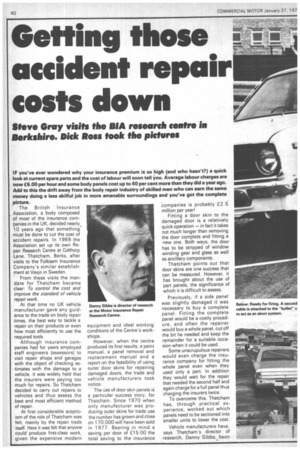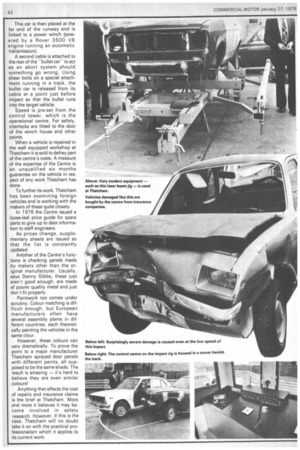Getting those accident repair costs down
Page 42

Page 43

Page 44

If you've noticed an error in this article please click here to report it so we can fix it.
Steve Gray visits the BIA research centre in Berkshire. Dick Ross took the pictures
IF you've ever wondered why your insurance premium is so high (and who hasn't?) a quick look at current spare parts and the cost of labour will soon tell you. Average labour charges are now £6.00 per hour and some body panels cost up to 40 per cent more than they did a year ago. Add to this the drift away from the body repair industry of skilled men who can earn the same money doing a less skilful job in picture. more amenable surroundings and you've got the complete The British Insurance Association, a body composed of most of the insurance companies in the UK, decided nearly 10 years ago that something must be done to cut the cost of accident repairs. In 1969 the Association set up its own Repair Research Centre at Colthorp Lane, Thatcham, Berks, after visits to the Folksam Insurance Company's similar establishment at Vaxjo in Sweden.
From these visits the mandate for Thatcham became clear: To control the cost and improve the standard of vehicle repair work.
At that time no UK vehicle manufacturer gave any guidance to the trade on body repair times, the best way to tackle a repair on their products or even how most efficiently to use the required tools Although insurance companies had for years employed staff engineers (assessors) to visit repair shops and garages with the object of checking estimates with the damage to a vehicle, it was widely held that the insurers were paying too much for repairs. So Thatcham decided to carry out repairs to vehicles and thus assess the best and most efficient method of repair.
At first considerable scepticism of the role of Thatcham was felt, mainly by the repair trade itself. Here it was felt that anyone could produce first-class work, given the expensive modern equipment and ideal working conditions of the Centre's workshops.
However, when the centre .produced its first results, a paint manual, a panel removal and replacement manual and a report on the feasibility of using outer door skins for repairing damaged doors, the trade and vehicle manufacturers took notice.
The use of door skin panels is a particular success story, for Thatcham. Since 1970 when only manufacturer was producing outer skins for trade use the number has grown and close on 170,000 will have been sold in 1977. Bearing in mind a saving per door of £15.00 the total saving to the insurance companies is probably £2.5 million per year!
Fitting a door skin to the damaged door is a relatively quick operation — in fact it takes not much longer than removing the door complete and fitting a new one. Both ways, the door has to be stripped of window winding gear and glass as well as ancillary components.
Thatcham points out that door skins are one success that can be measured. However, it has brought about the use of part panels, the significance of which it is difficult to assess.
Previously, if a side panel was slightly damaged it was necessary to buy a complete panel. Fitting the complete panel would be a costly procedure, and often the repairer would buy a whole panel, cut off the bit he needed and keep the remainder for a suitable occasion when it could be used.
Some unscrupulous repairers would even charge the insurance company for fitting the whole panel even when they used only a part. In addition they would wait for the repair that needed the second half and again charge for a full panel thus charging the insurers twice.
To overcome this, Thatcham has, through practical experience, worked out which panels need to be sectioned into smaller units to lower the cost.
Vehicle manufacturers have, says Thatcham's director of research, Danny Gibbs,_ been co-operative. Indeed, Thatcham now works with them at the design stage of new models, using its expertise to advantage by pointing out areas of bad design from a repair viewpoint.
In this way it is able to reduce awkward shapes and fitments which could add to repair costs. One manufacturer who didn't work in co-operation with Thatcham claims that the bolton wings on its vehicle can be removed and refitted in two hours.
While this is true, Thatcham points out that it takes four hours to remo've the bits and pieces around the wings.
Thatcham has a secure area, so pre-production vehicles can be examined avoiding the gaze of prying eyes.
At or around the launch date it is able to publish a booklet setting out the times for
replacing all outside body panels from its research on the undamaged model.
This booklet has diagrams, detailed information on how to carry out the work and includes. details of the tools needed. Following this, a stage two booklet is issued, which is a report on the validity of the first work based on research with damaged vehicles and which carries the work deeper into the body structure.
The difficulty of this type of research is the lack of late damaged vehicles. To overcome the problem Thatcham has installed its own rig to damage selected parts of a vehicle.
The vehicle under test is positioned at the end of a concrete strip so that the panel which is to be damaged is facing toward the car which is to hit it, This car is then placed at the far end of the runway and is linked to a power winch (powered by a Rover 3500 V8 engine running an automatic transmission).
A second cable is attached to the rear of the "bullet car" to act as an abort system should something go wrong. Using shear bolts on a special attachment running in a track, the bullet car is released from its cable at a point just before impact so that the bullet runs into the target vehicle.
Speed is pre-set from the control tower, which is the operational centre. For safety, interlocks are fitted to the door of the winch house and other points.
When a vehicle is repaired in the well equipped workshop at Thatcham it is sold to defray part of the centre's costs. A measure of the expertise of the Centre is an unqualified six months guarantee on the vehicle in respect of any work Thatcham has done.
To further its work, Thatcham has been examining foreign vehicles and is working with the makers of these quite closely.
In 1976 the Centre issued a loose-leaf price guide for spare parts to give up to date information to staff engineers.
As prices change, supplementary sheets are issued so that the list is constantly updated.
Another of the Centre's func.tions is checking panels made by makers other than the original manufacturer. Usually, says Danny Gibbs, these just aren't good enough, are made of poorer quality metal and just don't fit properly.
Paintwork too comes under scrutiny. Colour matching is difficult enough, but European manufacturers often have several assembly plants in different countries, each theoretically painting the vehicles in the same clour.
However, these colours can vary dramatically. To prove the point to a major manufacturer Thatcham sprayed door panels
with different paints, all supposed to be the same shade. The result is amazing — it's hard to believe they are even similar .colours!
Anything that affects the cost of repairs and insurance claims is the brief at Thatcham. More and more it believes it may become involved in safety research. However, if this is the case, Thatcham will no doubt take it on with the practical professionalism which it applies to its current work.




















































































































